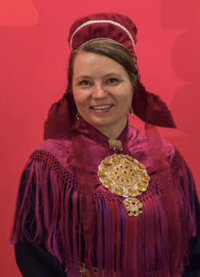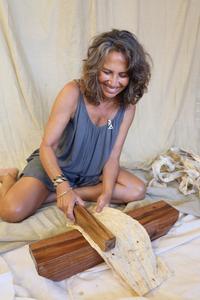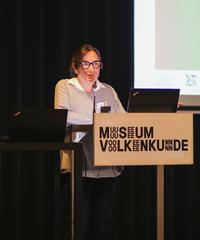Caring for Here and There Workshop
The objective of this workshop is to overcome the Eurocentric approach to conservation by developing innovative strategies that bring cultural care and preservation together. By sharing practice around analytical techniques, ethics, and understanding the needs of objects from an indigenous perspective, the aim is to progress preservation within participating museums as well as communities locally and internationally.
Abstracts and Speakers
Taking Care of the Significance
A conservator as a director of an indigenous museum puts some other priorities on the table. The collection is at the heart of the museum and our common heritage that we will pass on to future generations.
Repatriation is a way to give the origin society a possibility to restitute culture or parts of it that have been forgotten through time. On the other hand, the pesticide issues that we inherit through repatriation may prevent us from gaining new material understanding or restitute forgotten methodology. Climate change affects our traditional knowledge and the museum's role in society as a holder of knowledge is becoming more important. We have a holistic approach that includes our way of thinking. Our culture and tradition mean to take care of both the material and intangible significance.

Anne May Olli
Norwegian Sami
Master in Conservation from the University of Oslo (2013)
Director at the largest Sámi museum in Norway, RiddoDuottarMuseat (RDM), that consists of five local museums in the middle of Finnmark in Northern Norway. The administration is located in Karasjok at the Museum Sámiid Vuorká-Dávvirat. Olli has worked as a Conservator at one of the local museums in RDM for many years, with an emphasis on documentation of traditional Sámi technology and its use in conservation. Olli has a masters degree in pesticides in Sámi collections. In recent years she specialised in pesticide issues, before coming the RDM Director in 2015.
Olli is also a farmer and married into reindeer husbandry.
Kapa, Cultural Foundation of the Past, Present and Future
Kapa artist and Kumu (teacher), Page Chang believes that building upon successful Native Cultural Practices offers us a pathway to a sustainable future. She shares the cultural relevance of Napa in the past, and through the example of her modern Kapa making practice, the cultural relevance of Kapa in the present and as a link to an imagined healthier future.

Page Chang
Page is a Native Hawaiian practitioner, artist, designer and educator. She is dedicated to reclaiming and reintroducing the ancient practice of Hawaiian Kapa in her Hawaiian community and beyond. She has shared her practice with hundreds of school children and at the University of Hawaii, and conducts Kapa making workshops for adults and fellow educators. Her Kapa artworks are featured in local and national exhibitions, private homes and public spaces. Her fashion accessory designs are featured in Hawaiian shops, festivals and local and international publications.
Abstract
Scientific analysis of cultural heritage artefacts can reveal a wealth of information about their construction, materials and conservation histories. However, while non-destructive techniques can be informative (and should generally be the first approach), destructive sampling is often required to provide greater understanding. Reflecting on over 15 years' experience of sampling and analysing objects from collections in the UK, USA and the Caribbean, this session will highlight key considerations regarding sampling, analytical technique selection and dissemination.
Fiona Brock
With a degree in chemistry and a PhD and postdoctoral experience in biogeochemistry, Fiona developed her interests in archaeological and heritage science whilst working as the radiocarbon dating laboratory chemist at the Research Laboratory for Archaeology at Oxford University. Her current research as Reader in Analytical & Archaeological Science at Cranfield University often involves identifying and applying a range of analytical techniques to cultural heritage artefacts, generally in response to the questions "what is it?" or "how old is it?"! She works with archaeologists and conservators (and in particular has long-standing collaborations with the Pitt Rivers Museum and the National Museum of the Royal Navy) and enjoys working with multidisciplinary teams to investigate a range of artefact types and their conservation histories.
Can Digital Repatriation Matter?
In September and October 2022 Selk'nam activist Fernanda Olivares stayed together with Chilean artist Nicólas Spencer for a research residency at the Weltmuseum Wien. Fernanda is representative of the Covadonga Ona community, a group of Selk´nam from different cities and even countries who are fighting together for the official recognition as a living culture through the government of Chile.
After Fernanda returned to Chile and discussed her experiences with the community, two requests were addressed to the museum: to remove a ceremonial mask from the permanent exhibition and to repatriate a 3D print of this mask. In this presentation I will follow the traces of the mask through different spaces and materialities. What kind of connectedness can be found or constructed? And can arguments be found that digital repatriation of objects matter?

Claudia Augustat
Claudia is Head of the TAKING CARE Project and Curator for South American collections at Weltmuseum, Wien, Austria.
Claudia Augustat holds a PhD in cultural anthropology and has been curating the South America collections at Weltmuseum Wien since 2004. From 2015 to 2017, she was in charge of revising the new permanent exhibition at Weltmuseum Wien. She is the head of the project TAKING CARE: Ethnographic and World Culture Museums as Spaces of Care, co-funded by the European Union and initiated in October 2019. Her research focuses on collections from the Amazon and Tierra del Fuego, material culture and cultural memory, museum and colonialism, collaborative curatorship and decolonising museum practice.
Human Remains at the Pitt Rivers Museum: Why Care Matters
What does it mean to care for human remains in a museum context, and how is the definition of care changing? Faye Belsey and Joanna Cole will discuss recent work around human remains including the decision to remove from display and efforts towards repatriation and redress.
Faye Belsey and Joanna Cole, Pitt Rivers Museum
Using forensic ornithology to tell human-bird stories: analysing Shuar featherwork at the Smithsonian Feather Identification Lab
While attention has often been paid to the artistic merit of Indigenous featherworks, their value as archives of ornithological knowledge is rarely considered in any precise detail within collections research. The Feather Identification Lab at the Smithsonian offers a unique opportunity to explore how forensic ornithology techniques can be applied to the analysis of ethnographic objects. Whole feather analysis of Shuar featherworks from the Smithsonian Anthropological collections was undertaken through comparison with the Smithsonian’s extensive bird skin collections housed at the National Museum of Natural History. This talk presents what this analysis revealed about historical making processes and bird-human relations in Shuar featherworks. It considers the benefits of bringing natural history and anthropology collections together for developing new methods of analysis for biocultural objects and the value of working across departmental and disciplinary boundaries in museum practice.

Rosa Dyer
Rosa is an AHRC-funded Collaborative Doctoral Project student at Birkbeck College, University of London and the Pitt Rivers Museum, Oxford. Rosa has a BA in Human Social and Political Science from the University of Cambridge and an MSc in Ethnobotany from the University of Kent. Rosa’s research at the Pitt Rivers Museum is focused on the use of feathers in objects made by South American Indigenous peoples. The project takes an interdisciplinary approach, drawing from areas of anthropology, ethnobiology, ornithology and museum studies to consider the dynamic relationships held between Indigenous peoples, birds and environments.




